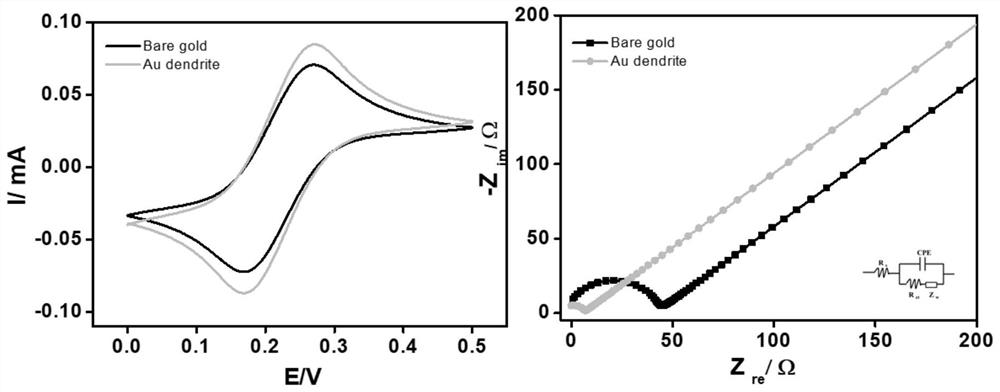Method for detection of antigen content in samples based on immunohistochemical space electrochemistry
A technology for antigen content and sample detection, applied in the biological field, can solve problems such as high technical requirements, low sensitivity, and complicated operation, and achieve the effect of low technical requirements, improved sensitivity, and simple operation
- Summary
- Abstract
- Description
- Claims
- Application Information
AI Technical Summary
Problems solved by technology
Method used
Image
Examples
Embodiment 1
[0078] Electrode modification flow chart as figure 1 As indicated, take 30mM HAuCl 4 , 0.1M Na 2 SO 4 , in chloroauric acid and sodium sulfate solution, use chronoamperometry to electroplate the surface of the electrode to obtain dendritic gold, and the morphology of the obtained dendritic gold is as follows figure 2 shown. Using cyclic voltammetry and electrochemical impedance method to compare the current resistance value of the electrode before and after dendritic gold modification, such as image 3 shown.
[0079] Dissolve the conductive polymer monomer (ethylenedioxythiophene in this example) and tetrabutylammonium perchlorate in anhydrous acetonitrile, pass through nitrogen, remove the air in the solution, and use cyclic voltammetry to dissolve the conductive polymer electroplating on the surface of the dendritic gold to obtain an electrode modified with the dendritic gold and the conductive polymer.
[0080] Among them, the concentrations of conductive polymer mo...
Embodiment 2
[0089] Take 30mM HAuCl 4 , 0.1M Na 2 SO 4 , Dendritic gold was obtained after electroplating by chronoamperometry, and conductive polymer monomers such as ethylenedioxythiophene, thiopheneacetic acid, and pyrrole were dissolved in anhydrous acetonitrile, and nitrogen gas was introduced to remove the solution In neutral air, polymers were electroplated on dendritic gold surfaces using cyclic voltammetry. In a solution containing 1-(3-dimethylaminopropyl)-3-ethylcarbodiimide hydrochloride and N-hydroxysuccinimide, ferrocene was added to co-culture with specific antibodies, and then the to-be-detected The slides of the frozen section tissue were immersed in the solution, co-incubated, the slides were removed, and the electrochemical signals of unbound antibodies in the solution were detected. The process is as follows: Figure 7 shown.
Embodiment 3
[0091] Take 30mM HAuCl 4 , 0.1M Na 2 SO 4, dendritic gold was obtained after electroplating the electrode surface using chronoamperometry. Dissolve conductive polymer monomers such as ethylenedioxythiophene, thiopheneacetic acid and pyrrole with tetrabutylammonium perchlorate in acetonitrile, pass through nitrogen, remove the air in the solution, and use cyclic voltammetry to electroplate the conductive polymer on the A dendritic gold surface, and an electrode modified with a dendritic gold and a conductive polymer is obtained. The electrochemical signal (ferrocene), in the presence of 1-(3-dimethylaminopropyl)-3-ethylcarbodiimide hydrochloride and N-hydroxysuccinimide in acetonitrile and Specific antibodies were co-incubated to obtain antibodies modified by electrochemical signals. Add the antibody modified by the electrochemical signal to the cells to be detected, and incubate together to carry out the binding of the antigen and antibody, centrifuge to remove the unbound...
PUM
 Login to View More
Login to View More Abstract
Description
Claims
Application Information
 Login to View More
Login to View More - R&D
- Intellectual Property
- Life Sciences
- Materials
- Tech Scout
- Unparalleled Data Quality
- Higher Quality Content
- 60% Fewer Hallucinations
Browse by: Latest US Patents, China's latest patents, Technical Efficacy Thesaurus, Application Domain, Technology Topic, Popular Technical Reports.
© 2025 PatSnap. All rights reserved.Legal|Privacy policy|Modern Slavery Act Transparency Statement|Sitemap|About US| Contact US: help@patsnap.com



